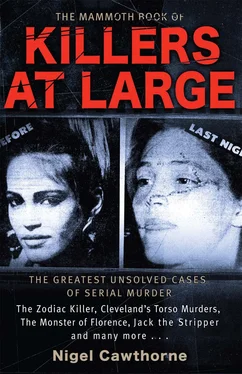The woman’s clothes were never found. Nor were her head and limbs. However, from the parts that reached the morgue, it was possible to ascertain that she was in her mid-twenties, had a light complexion and medium brown hair, and weighed around 100 to 120 pounds. She had been pregnant at least once and she had lived in the city as there was dirt in her lungs, causing moderate emphysema. But that was all that was known of Victim Seven. Her identity was never discovered.
Nevertheless the forensic work brought the new Coroner Sam Gerber a great deal of favourable publicity—oxygen for an elected official. Gerber then devoted his time to writing up his conclusion which he published in March 1937. Again he deduced that all the killings were the work of one man. The killer was right-handed and used a sharp, heavy knife rather than a medical instrument. As to motive, Gerber believed the killer to be a sexual psychopath, the first on record to murder both sexes. His knowledge of anatomy was also clear and Gerber pushed the idea he was a medical student, male nurse, surgeon or veterinary practitioner.
Gerber’s report brought him into conflict with Eliot Ness. While Gerber aimed to hog the limelight with his theories, Ness asked the newspapers to scale down their coverage on the grounds that the exposure was inflating the killer’s ego and might encourage him to kill again. The sensationalism surrounding the murders was also bringing in thousands of useless tips, everyone of which had to be followed up. Much to Gerber’s annoyance, the newspaper editors agreed to curtail their coverage.
However, they could not keep a lid on public interest when, on 6 June 1937, Victim Eight appeared. A teenager named Russell Lawer had been watching the Coast Guard boats on the Cuyahoga River when, on his way home, he found a human skull about 400 feet west of Stone’s Levee under the fifth span of the Lorain-Carnegie Bridge. Next to it was a rotting burlap bag, containing skeletal remains, wrapped in a newspaper from June 1936. The lab agreed that the victim had been dead for around a year.
Although the arms and legs were missing, the victim’s delicate bones showed she was a petite woman, less than five feet tall and around 40 years old. The skull showed extensive dental work a several of her teeth had been crowned with gold. She had had a wide nose and a prominent mouth. Her hair was kinky and fastened to it with a rusty hairpin was a black wig. Gerber concluded that she was an African-American.
Although the skull was found separate from the rest of the skeleton, it was impossible to tell whether the cause of death had been decapitation. There was little cartilage and flesh left as the body had been treated with quicklime. However, there was “considerable hacking and cutting of the 3rd, 4th and 5th cervical vertebrae”—indicating that the perpetrator had not demonstrated the Mad Butcher’s normal level of skill.
The skull’s dental work led to the unofficial identification of the victim as a prostitute named Rose Wallace of Scovill Avenue who had disappeared in August 1936. A lengthy investigation led nowhere, leading Sergeant Hogan and Coroner Gerber to believe that the victim was not Rose Wallace at all, though Detective Merylo continued to believed that it was.
There were labour problems in the Cleveland in the summer of 1937 and the Ohio National Guard were called in to maintain order. On 6 July, a young guardsman on watch by the West Third Street bridge saw the upper part of a man’s torso bobbing in the water in the wake of a passing tugboat. Over the next few days, police recovered most of the body parts from the waters of the Cuyahoga River, though the head was missing. The victim had been dead a couple of days when the first parts were found. The man was in his mid to late 30s. He was around five foot eight, weighed around 150 pounds and had well-groomed fingernails.
The cause of death was, once again, decapitation. But this time some of the surgery had been sloppy and some was very skilful. For the first time, the internal organs including the heart had been ripped out, indicating a new element of viciousness in the killer’s modus operandi. None of the internal organs were ever found and the victim was never identified.
At Gerber’s instigation, the investigation now began to concentrate on medics. Detectives combed the records for doctors that had a weakness for drink, drugs or illicit sex—particularly of a homosexual nature. They soon happened upon Dr Frank E. Sweeney, a physician who fitted the physical profile of the murderer that the Torso Clinic had come up with. Sweeney was very tall, large and physically strong. He had grown up in the Kingsbury Run area and, at various times, had practised there.
At one time Sweeney had been a resident surgeon at St Alexis, a hospital close to Kingsbury Run. But he had lost his job because of drunkenness. At the same time he had been separated from his wife and sons. He was violent when drunk and there were rumours that he was a bisexual. It seemed that, at last, the police had a suspect.
But soon the police dropped Dr Sweeney from their investigations because he had an alibi. He was often out of town at the Sandusky Soldiers’ and Sailors’ Home, a veterans’ hospital 50 miles to the west of Cleveland, when the Mad Butcher was at work. And although Dr Sweeney was not related to Inspector Joseph Sweeney, the chief of detectives on the case, he was a first cousin to the outspoken US Congressman Martin L. Sweeney.
A Democrat, Martin L. Sweeney was a fierce critic of Mayor Burton and his Republican administration. Earlier that year he had launched a scathing attack on Mayor Burton’s “alter ego, Eliot Ness” who, he said, spent all his time persecuting cops that took $25 bribes from bootleggers years before while doing nothing to catch major criminals such as the Mad Butcher of Kingsbury Run. This meant investigating Dr Sweeney would be politically embarrassing. With municipal elections in the offing, the Congressman was urging voters to “send back to Washington the prohibition agent who is now safety director”. However, with the help of the Ohio National Guard, Ness chalked up a considerable victory against “labour racketeers”. His job was safe, but he still had little time to devote to the Torso Murders.
In mid-March 1938, a dog found the severed leg of a man in a swampy area near Sandusky, just down the coast of Lake Erie from Cleveland. Desperate for a lead, Lieutenant Cowles drove out to Sandusky personally to see if there was any link between the leg and the Mad Butcher. However, it was soon discovered that the leg was part of hospital refuse not properly disposed of. It had been removed during legitimate surgery and had nothing to do with the Mad Butcher.
But while he was in Sandusky, Cowles recalled that one of the doctors who had been a suspect in the Mad Butcher case had been eliminated because he had been at the veterans’ hospital in Sandusky when the Cleveland murders occurred. So Cowles decided to pay the hospital a visit.
He quickly confirmed that Dr Sweeney had voluntarily admitted himself to the Sandusky Soldiers’ and Sailors’ Home to treat his alcoholism at times when the Mad Butcher was at work, confirming his alibi. However, when Cowles enquired further, he discovered that patients were not watched closely and a voluntary patient who had checked in with a drinking problem would not really be watched at all. Security was nonexistent and, at weekends and holidays, there were so many visitors that it would be impossible for the nursing staff to keep track of a patient’s movements. It was not unusual for alcoholics to disappear on a binge for a day or two, then return, without having been discharged. Cowles concluded that it would have been easy for Dr Sweeney to travel to Cleveland by train or car, commit the murders, dump the bodies and return without his absence being recorded.
Читать дальше











